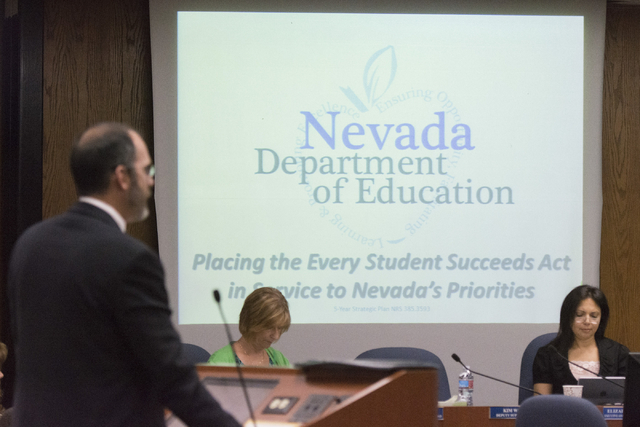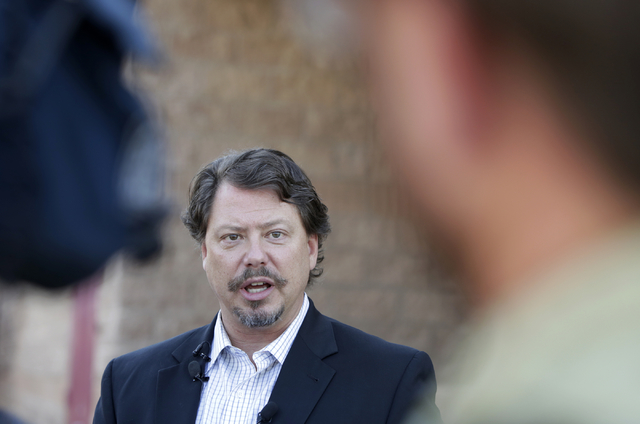Officials scramble to finalize details of Clark County School District breakup
Pat Skorkowsky, superintendent of the Clark County School District, hasn’t enjoyed much sleep lately.
Since Sept. 9, when a bipartisan panel of lawmakers unanimously approved an ambitious plan to overhaul the nation’s fifth-largest school system, Skorkowsky and his staff have scrambled to finalize details of the top-to-bottom reorganization of the district.
The superintendent, after meeting with community leaders earlier in the month, went on what he described as a road tour this week to brief central and campus administrators on the expectations and hurdles included in the plan. His staff, meanwhile, has traded a barrage of emails and kept hourly — not daily — timestamps of edits made to planning documents.
The rapid pace of their efforts is justified: The plan requires the district by August 2017 to convert from a top-down system in which central administration controls most decisions and spending to a bottom-up design that guarantees principals and school communities more authority over their budget, instruction and staffing priorities.
Skorkowsky has acknowledged no other district has gone through such a transformation, leaving administrators with little guidance on the best way to whittle away at their own power or how to train principals in their new role as empowered campus leaders.
Regardless, he has set an aggressive timeline to prepare his sprawling district for the unprecedented change.
“A great deal of work has been accomplished in less than two weeks on this process,” Skorkowsky said Thursday.
“The overall goal is to have 90 percent of the work done by early December so that we can move forward with the implementation,” he added.
FIRST STEPS
Starting next week, the district will send to all schools the first of five training videos to prepare principals, teachers and staff for the reorganization. 
That initial video will focus on how campus-level workers — rather than central administrators — should handle their newfound control of the school budget.
Regulations passed on Sept. 9 to support the reorganization require the district to funnel at least 80 percent of its unrestricted general fund to individual schools.
“What we’re trying to train our entire school populations on is the types of funds that will be available to schools (and) the restrictions on certain funds,” Skorkowsky said.
Training topics will cover positive campus culture, public data and more. And principals will receive biweekly videos throughout the next year to ensure all schools remain in step with each other.
The district has not yet determined how — and at what cost — it will train parents on the new school model.
Under the plan, parents may serve alongside teachers and support staff on site teams that advise principals on how to operate their school and prepare their annual budget.
Those teams cannot be established until the teachers and support staff unions agree on how their membership will select representatives to serve on each team, according to Skorkowsky.
“We’re still struggling with what supports we need to provide the parents,” he said.
Of the more than 350 schools in the district, at least 150 have no active parent group.
Meanwhile, Skorkowsky within the next two months plans to fill 16 vacancies for new central administrators, to be called school associate superintendents.
That position replaces the current set of supervisors who oversee geographic clusters of schools, and that supervisory map will remain as the associate superintendents train principals during the first year of the reorganization.
“Their role shifts from one of a direct supervisor to a coach (and) a mentor,” Skorkowsky said.
“They will be the gatekeepers of (laws and regulations) and monitoring how the implementation of the plan is going,” he added.
‘A LOT OF NUANCE HERE’
At the state level, technocrats at the Nevada Department of Education soon must put the finishing touches on a new school finance formula that would increase a basic per-pupil funding amount for students with greater needs.
State law currently requires the adoption of such multipliers for special needs children, English learners and other students by 2022. But bipartisan support has grown to accelerate that finance structure to next year, and lawmakers who supported the reorganization especially hope to provide more resources to schools with higher shares of at-risk students.
However, earlier adoption of the new finance formula would come with a price tag of $1.2 billion to $1.5 billion, said Steve Canavero, state superintendent of public instruction.
“I have asterisks all over that proposal,” he said, “and caution anyone to consider these to be hard-baked numbers. There’s a lot of nuance here.”
As for the 2017 Nevada Legislature, “if they’re able to bring the revenue, then absolutely I’m not opposed to providing additional resources,” Canavero said.
For his part, Skorkowsky supports the accelerated timeline. But even before lawmakers return to Carson City, he must deliver to principals on January 15 a budget workbook that details how much money each school can use to meet the unique needs of their students.
“This first year we need to see what the state does, because that has implications for the legislative session,” Skorkowsky said.
“That weighted funding formula has to be a priority if we’re going to allow schools to have the monies that they need to have a significant impact on student achievement,” he added.
Contact Neal Morton at nmorton@reviewjournal.com or 702-383-0279. Find @nealtmorton on Twitter.




















